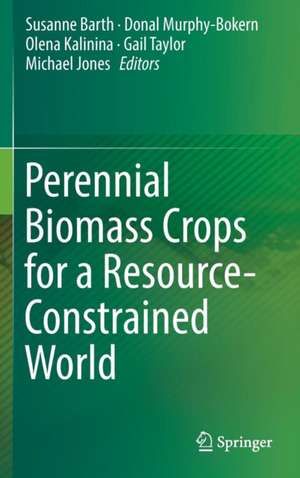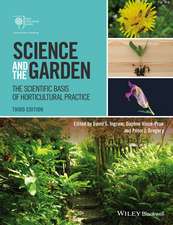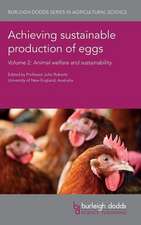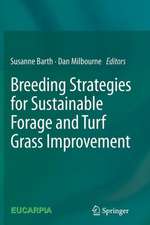Perennial Biomass Crops for a Resource-Constrained World
Editat de Susanne Barth, Donal Murphy-Bokern, Olena Kalinina, Gail Taylor, Michael Jonesen Limba Engleză Hardback – 19 noi 2016
| Toate formatele și edițiile | Preț | Express |
|---|---|---|
| Paperback (1) | 1218.69 lei 6-8 săpt. | |
| Springer International Publishing – 30 apr 2018 | 1218.69 lei 6-8 săpt. | |
| Hardback (1) | 1224.68 lei 6-8 săpt. | |
| Springer International Publishing – 19 noi 2016 | 1224.68 lei 6-8 săpt. |
Preț: 1224.68 lei
Preț vechi: 1493.51 lei
-18% Nou
Puncte Express: 1837
Preț estimativ în valută:
234.36€ • 246.43$ • 193.64£
234.36€ • 246.43$ • 193.64£
Carte tipărită la comandă
Livrare economică 17 aprilie-01 mai
Preluare comenzi: 021 569.72.76
Specificații
ISBN-13: 9783319445298
ISBN-10: 3319445294
Pagini: 300
Ilustrații: XVIII, 313 p. 74 illus., 54 illus. in color.
Dimensiuni: 155 x 235 x 27 mm
Greutate: 0.64 kg
Ediția:1st ed. 2016
Editura: Springer International Publishing
Colecția Springer
Locul publicării:Cham, Switzerland
ISBN-10: 3319445294
Pagini: 300
Ilustrații: XVIII, 313 p. 74 illus., 54 illus. in color.
Dimensiuni: 155 x 235 x 27 mm
Greutate: 0.64 kg
Ediția:1st ed. 2016
Editura: Springer International Publishing
Colecția Springer
Locul publicării:Cham, Switzerland
Cuprins
Part 1. Introduction Into Bioenergy Resources from Perennial Crops.- The Role of Perennial Biomass Crops in a Growing Bioeconomy.- Pointers for Bioenergy Policy in a Resource-Constrained World.- Perennial Grasses for sustainable European Protein Production.- Long Term Yields and Soil Carbon Sequestration from Miscanthus – A Review.- Miscanthus-Complemented Grassland in Europe – Additional Source of Biomass for Bioenergy.- Part 2. European Regional Examples for the Use of Perennial Crops for Bioenergy.- ‘Soranovskii’: a New Miscanthus Cultivar Developed in Russia.- Italian Experiences on Arundo Harvesting: Economic and Energy Appraisal.- Biomass Potential of Fibre Nettle in Lithuania.- An Evaluation of Grass Species as Feedstocks for Combustion in Ireland.- Part 3. Genotypic Selection of Perennial Biomass Crops for Crop Improvement.- New Breeding Collections of Miscanthus sinensis, M. sacchariflorus and Hybrids from Primorsky Krai, Far Eastern Russia.- Creation of Novel Tetraploid Miscanthus sinensis Genotypes.- A Review of Frost and Chilling Stress in Miscanthus and Its Importance to Biomass Yield.- Creation of Novel Cold Tolerant Miscanthus Hybrids.- Comparison of Different Miscanthus Genotypes for Ash Melting Behavior at Different Locations.- Bioenergy Trees: Genetic and Genomic Strategies to Improve Yield.- Screening of Giant Reed Clones for Phytoremediation of Lead Contaminated Soils.- Variation in Selected Traditional Grass Species in Relation to Moisture Loss Rate in Biomass Cut at Anthesis.- Part 4. Ecophysiology of Perennial Biomass Crops.- A Systems Approach Guiding Future Biomass Crop Development on Marginal Land.- Mycorrhiza-Based Biofertilizer Application to Improve the quality of Arundo donax L., plantlets.- Biomass Yield and N Uptake in Tall Fescue and Reed Canary Grass Depending on N and PK Fertilization on Two Marginal Sites in Denmark.- Energy Balance of Cardoon (Cynara cardunculus L.) Cultivation and Pyrolysis.- Part 5. Examples for End-Use of Perennial Biomass Crops.- Harvesting and Separation of Different Plant Fractions in Cynara cardunculus L.- Masonry Blocks from Lightweight Concrete on the Basis of Miscanthus as Aggregates.- Miscanthus Horse Bedding Compares Well to Alternatives.
Textul de pe ultima copertă
This book presents a flavour of activities focussed on the need for sustainably produced biomass to support European strategic objectives for the developing bioeconomy. The chapters cover five broad topic areas relating to the use of perennial biomass crops in Europe. These are: ‘Bioenergy Resources from Perennial Crops in Europe’, ‘European Regional Examples for the Use of Perennial Crops for Bioenergy’, ‘Genotypic Selection of Perennial Biomass Crops for Crop Improvement’, ‘Ecophysiology of Perennial Biomass Crops’ and ‘Examples of End-Use of Perennial Biomass Crops’. Two major issues relating to the future use of biomass energy are the identification of the most suitable second generation biomass crops and the need to utilise land not under intensive agricultural production, broadly referred to as ‘marginal land’. The two main categories of plants that fit these needs are perennial rhizomatous grasses and trees that can be coppiced. The overarching questions that are addressed in the book relate to the suitability of perennial crops for providing feedstocks for a European bioeconomy and the need to exploit environments for biomass crops which do not compete with food crops. Bioenergy is the subject of a wide range of national and European policy measures. New developments covered are, for example, the use of perennial grasses to produce protein for animal feed and concepts to use perennial biomass crops to mitigate carbon emissions through soil carbon sequestration. Several chapters also show how prudent selection of suitable genotypes and breeding are essential to develop high yielding and sustainable second generation biomass crops which are adapted to a wide range of unfavourable conditions like chilling and freezing, drought, flooding and salinity. The final chapters also emphasise the need to be kept an eye out for potential new end-uses of perennial biomass crops that will contribute further to the developing bioeconomy.
Caracteristici
Advances in the breeding, production, processing and life cycle analysis of perennial crops Research presented by leading researchers and technologists in non-food biomass production and utilisation Up-to-date analysis on perennial crops breeding and physiology under marginal site conditions











